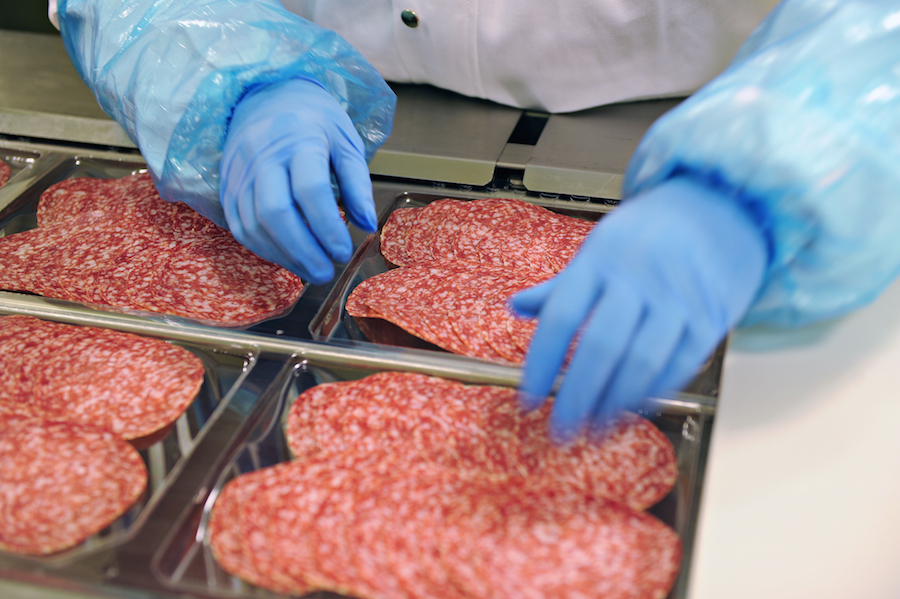
By Steve Ardagh, Founder and CEO, Eagle Protect PBC
In response to PVC’s toxic threats, global governments and corporations have passed policies to phase out PVC, including vinyl (PVC) gloves, and switch to safer, healthier PVC-free products.
This article explains the food safety implications of vinyl gloves and their potential adverse effects on both human and environmental health, with food safe and cost-effective alternatives.
Human health
Phthalates
Up to 50% of disposable vinyl glove raw materials are made from plasticizers, which make PVC flexible and soft enough to wear. Often plasticizers contain the phthalates DiNP, DEHP, and BPA as they are inexpensive.
Phthalates have been shown to leach from products into the human body via ingestion, inhalation, and dermal absorption (Zota et al, 2015). Because they are not chemically bound to PVC, phthalate plasticizers can easily leach and evaporate into food, particularly fatty foods such as butter, oils, and meat – where they become mostly soluble.
Exposure to DEHP has been associated with adverse reproductive, neurobehavioral, and respiratory outcomes in children (Braun et al, 2013; Ejaredar at al 2015) and metabolic disease risk factors such as insulin resistance in adolescents and adults (James-Todd et al. 2012; Trasande and Attina 2015).
Both DiNP and DEHP have been added to the Proposition 65 list of chemicals known to California to cause cancer.
Studies conducted in Japan found use of disposable PVC gloves during the preparation and packaging of meals was a major source of dietary intake of DEHP (Tsumura et al 2001a). The same study also demonstrated a decline in DEHP levels in prepared meals after the ban of DEHP in PVC gloves in Japan (Tsumura et al 2003).
Food safety & worker issues
Due to the microstructural organization of vinyl disposable gloves, there are associated risks that limit their performance and affect barrier protection, with the following food safety and worker related problems:
- Studies highlight the lack of cross-linking of the PVC polymer and together with plasticizers which weaken the vinyl glove structure, micro-punctures will occur within only a few hand flexes or food handling tasks undertaken by the glove wearer. In some cases vinyl gloves begin leaking as soon as they are donned.
- It is estimated 50% to 90% of punctures go unrecognized by wearers, resulting in drops of contamination smeared over surfaces contacted by gloves and contamination of food.
- Numerous studies have proven vinyl gloves have an increased permeability to bacteria and virus, further compromising food safety.
- Work-related musculoskeletal disorders – Vinyl disposable gloves have a poor resistance to stretch and elongation. With reduced elasticity and flexibility, a thicker glove is required, increasing glove resistance and bulkiness, causing repetitive fatigue injuries and contact trauma to fingers and thumbs.
Cross-contamination risks of vinyl gloves
There is an accumulation of scientific evidence indicating vinyl disposable gloves (over other types) are more frequently responsible for cross-contamination events in food handling where glove type is identified.
The science of cross-contamination is complex, involving the physical chemistry of surfaces, soils and pathogens. Liquid and soil transfer to and from surfaces are controlled by forces of attraction governed by the surface tension of liquids (or semi-solids) and the surface free energy of surfaces.
Recent research conducted by international food safety consultant Barry Michaels has shown the risk of cross-contamination via vinyl gloves when used in food handling is significant – read the research summary and why quality nitrile gloves can reduce cross-contamination risk.
Environmental impacts
A proper accounting of the human health impacts of PVC across its lifecycle, including manufacturing and disposal issues and occupational exposure, finds PVC leads to the release of dangerous quantities of dioxin and other carcinogens. A report from the U.S. Green Building Council found, “When we add end of life with accidental landfill fires and backyard burning, the additional risk of dioxin emissions puts PVC consistently among the worst materials for human health impacts…”
Going PVC-free & why
In response to the health and environmental threats of PVC, below are some of the changes adopted around the world to switch to safer, healthier PVC-free products:
- In 2001 Japan banned PVC gloves for food handling due to the well documented adverse effects on health.
- The European Union (2008) banned the use of DEHP in food service gloves out of concern the chemical will leach into food and be ingested.
- Phthalates were banned in toys in the US in 2008 and restrictions or bans have been placed on phthalates in PVC toys in the entire European Union.
- Sweden first proposed restrictions on PVC use in 1995 and is working toward discontinuing all PVC use.
- In Spain, over 60 cities have been declared PVC-free.
- Germany has banned the disposal of PVC in landfills.
- Out of concern for toxic chemicals in products, healthcare institutions around the world, including Kaiser Permanente, are reducing or have removed PVC and phthalates from products, including vinyl gloves. Hospitals are particularly concerned as several government agencies, including the FDA, have concluded children undergoing certain medical procedures may represent a population at increased risk for the effects of DEHP.
Despite all the evidence against the use of vinyl disposable gloves, why do they remain the predominant food handling glove used in the US, amplifying risks to food safety?
Cost is one factor, and historical purchasing decisions another. There is also a lack of information from glove suppliers as to the food safety dangers of disposable vinyl gloves to consumers, workers and ultimately food handling companies. Glove choice decision making often fails to factor in food safety aspects, giving a false sense of security and economy.
Food safe vinyl glove alternatives
Nitrile gloves are a food safe and cost-effective alternative. Recent advances in the raw material formulations and manufacturing of nitrile gloves have resulted in thinner yet stronger, more flexible and better fitting gloves. The higher the quality of nitrile glove, the less failures (holes and rips), mitigating the risks of food contamination from a disposable glove.
Due to the raw material formulation and processes undertaken during manufacturing, better quality nitrile gloves have unique surface characteristics with overall surface energy and transfer characteristics similar to Teflon®, reducing the risk of potential cross-contamination in ready-to-eat foods, read more here.
 Steve Ardagh is the founder and CEO of Eagle Protect. After establishing Eagle Protect as an industry leader in New Zealand, he relocated to the US and launched Eagle Protect PBC, bringing Eagle’s values of providing products that are certified food safe, ethically sourced and environmentally better. Steve is driven to keep consumers safe by reducing the risk of foodborne illness one high-quality disposable glove at a time.
Steve Ardagh is the founder and CEO of Eagle Protect. After establishing Eagle Protect as an industry leader in New Zealand, he relocated to the US and launched Eagle Protect PBC, bringing Eagle’s values of providing products that are certified food safe, ethically sourced and environmentally better. Steve is driven to keep consumers safe by reducing the risk of foodborne illness one high-quality disposable glove at a time.
 Barry Michaels is an international scientific consultant on food safety, infectious disease transmission and glove use, and an independent advisor to academic institutions, government regulatory agencies, industry and nonprofit organizations. He has a lifetime of experience in infectious disease investigation, control and prevention in food and healthcare industries.
Barry Michaels is an international scientific consultant on food safety, infectious disease transmission and glove use, and an independent advisor to academic institutions, government regulatory agencies, industry and nonprofit organizations. He has a lifetime of experience in infectious disease investigation, control and prevention in food and healthcare industries.
Eagle Protect is collaborating with Barry Michaels, international scientific consultant on food safety, to further food safety research and education, and to advance food safety practices for their customers.
Full details of this research can be found in Michaels B, 2017. Summary of Hand & Glove Surface Cross-Contamination Potential in Retail Deli, Food Processing & Service Environments Based on Surface Energy Studies (Available upon request from Eagle Protect PBC). Visit www.eagleprotect.com for more food safety information, and download a summary of the latest research here.







